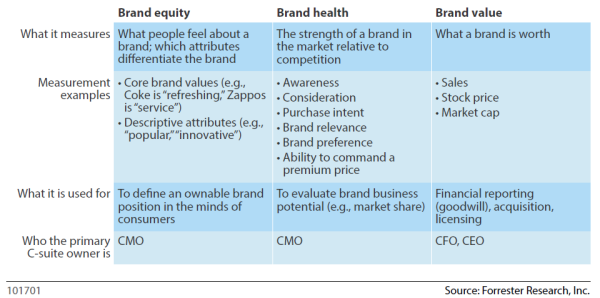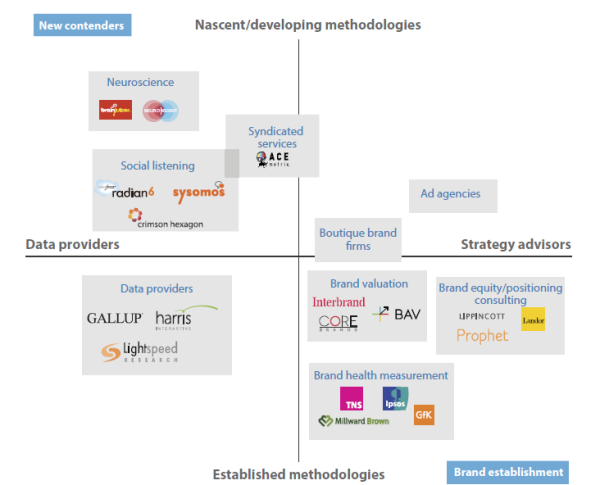Study: Media Consumption & Evolving Role Of CMO Changing The Way Brands Are Measured
Forrester released their Brand Health Measurement Is Ripe for Digital Disruption report this week, examining the new landscape of brand health measurement and the changing role of brand health measurement vendors. After interviewing 14 different brand measurement firms, the research company discovered that the methods for tracking the strength of a brand are transforming. According […]

After interviewing 14 different brand measurement firms, the research company discovered that the methods for tracking the strength of a brand are transforming. According to the report, the two major “disruptions” in brand health measurement revolve around the exponential growth of consumer media consumption and the developing role of the CMO from a “communications expert” into a “business leader” focused on ROI.
Defining brand health measurement as, the link between mindshare – consumers’ preference for a brand – and market share – consumers’ usage of a brand, the Forrester report claims that brand health measurement must, “Evolve to become an effective assessment of the business value a brand delivers to a corporation,” versus a, “Soft metric of interest only for right-brained marketers.”
The Challenges of Measuring a Brand’s Health
Before expanding on what currently drives brand health and the role of brand health measurement vendors, the report cites challenges that come with measuring a brand’s health, listing the disconnect between traditional methodologies of data collection (online surveys) and its ineffectiveness with today’s over-extended consumer who has little time for a lengthy questionnaire.
The Forrester report also references the abundance of data and the challenges it creates, claiming that the influx of information leaves marketing leaders overwhelmed and in need of experts to interpret the data and offer actionable insight.
The report also cites the new challenges of an ROI-driven CMO who is focused on business results, “The new Gen X CMO now taking over from her Baby Boomer predecessor grew up in a digital world of real-time data; she will have little patience for long lead times and historical brand trackers.”
The New World of Brand Health Measurement
Forrester’s report says that, in the new world of brand health measurement, brands are now a “quantifiable financial asset” with the brand research firm Millward Brown calculating, “More than 30 percent of market capitalization of S&P 500 companies was derived from the intangible asset of their brands.”
The report emphasizes how today’s leading brand health measurement vendors do more than report on past performance, with firms now able to connect a brand’s current market share with its expected growth. Millward Brown’s chairman of global solutions Gordon Pincott validates the report findings, stating:
The only thing that matters is how [brand equity] plays through to the financial strength of the brand…There’s no point in figuring out what’s in people’s heads unless you can link it to potential in the market.
In the report, Forrester goes on to say that the amount a consumer is willing to pay for a brand indicates the brand’s overall strength, confirming the idea that pricing power is “no longer conceptual.”
Three Primary Drivers Of Brand Health Measurement
For a brand to have a full-view of its total strength, Forrester defines the three primary evaluation disciplines as brand equity, brand value and brand health. The report states that brand equity illustrates, “How consumers perceive a brand, without consideration for brand usage,” while brand health concentrates on a consumer’s perception of a brand and how it affects the brand’s market share.
Brand value is defined as a measurement CFOs use to realize a brand’s financial value within the corporation. According to the report, brand value, “Is most commonly used for financial reporting to define goodwill, the value of an acquisition, or the appropriate price for licensing.”
The Role of Brand Health Measurement Vendors
Forrester’s analysis of brand health measurement vendors found that firms fall into two specific categories: strategic advisors and data providers. The report identified leading brand firms like Millward Brown, Interbrand, BAV and Landor as vendors that offer strategic guidance, and new technology companies such as Crimson Hexagon, Visible Technologies and Networked Insights as “social listening vendors” that capture real-time social media insights.
For leading brand health measurement agencies to remain on top, the report claims that vendors will need to reconsider their existing models for measuring brand health, and begin to integrate new methodologies.
Forrester outlines a number of initiatives vendors can implement to better serve global brands, including:
- Following the lead of “innovative marketers” by implementing new research tools and technologies.
- Linking consumers’ brand perceptions to specific metrics like market share, and creating predictive models that can forecast a brand’s performance.
- Offering deep industry experience combined with a global reach.
- Moving away from “brand tracking” tactics and closer to “brand deep dive” research and social listening.
The report claimed that “less progressive marketers” continue to push back on such switching their brand tracking models to more quantitative research and tools to monitor social conversations, fearing jobs security, existing performance incentive programs, and “lack of proven results for new tools and methodologies.”
The Ways Social Listening Is Changing Brand Health Measurement
Noted as one of the two major disruptions in brand health measurement, social listening – the ability to see what consumers are saying and sharing about a brand in real-time – may be a major force in the new landscape of brand health, but the Forrester report claims it is only a, “Complement, not a replacement, for established brand health measurement.”
According to the report, because social listening is based on “short-term reactions” versus “long-term beliefs,” and offers data over guidance, it is better used as a discovery tool than a measuring stick:
Social listening can effectively function as a real-time focus group that brings marketers’ insights into the “why” behind their brand metrics.
While Forrester doesn’t believe social listening vendors will be able to compete with full-service brand measurement vendors, the research firm does state that the leading brand measurement vendors will leverage social listening methodologies in the next 24 to 48 months, if they’re not doing so already.
Along with social listening tools, the report claims that data aggregation will be the next step beyond simply collecting research. According to the report, Ace Metrix CEO Peter Daboll says, “The whole industry will move from research collection to analysts who integrate the data,” with data analytic tools that offer clear insight.
And while the top brand health measurement vendors will continue to lead, Forrester sees room for new digital solution startups to challenge existing rules and budgets of the brand health industry.
Opinions expressed in this article are those of the guest author and not necessarily MarTech. Staff authors are listed here.
Related stories

